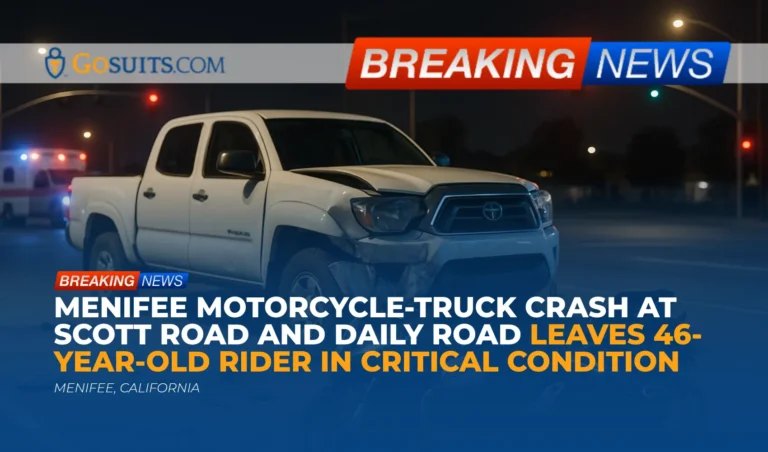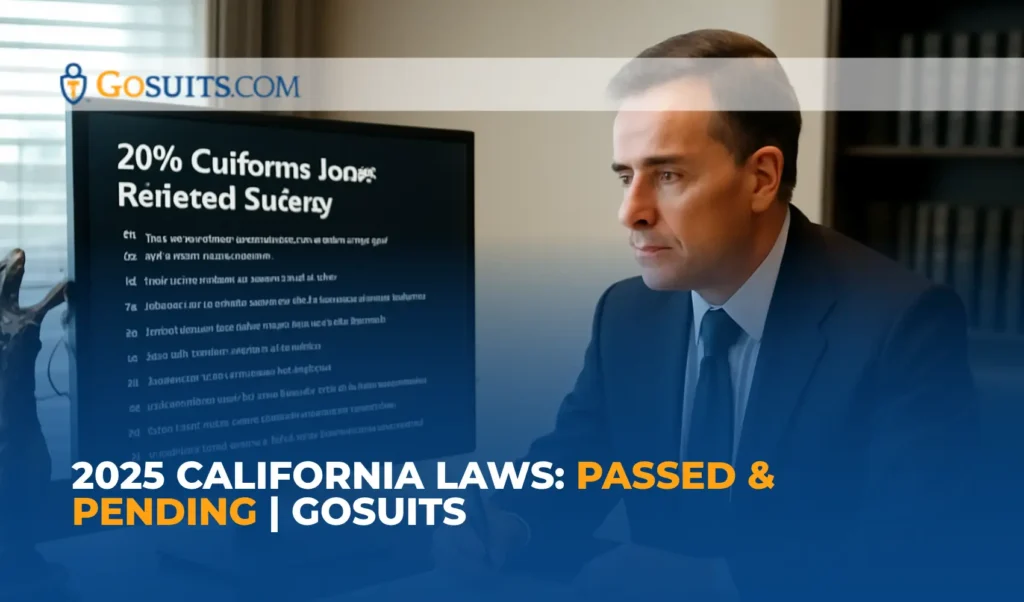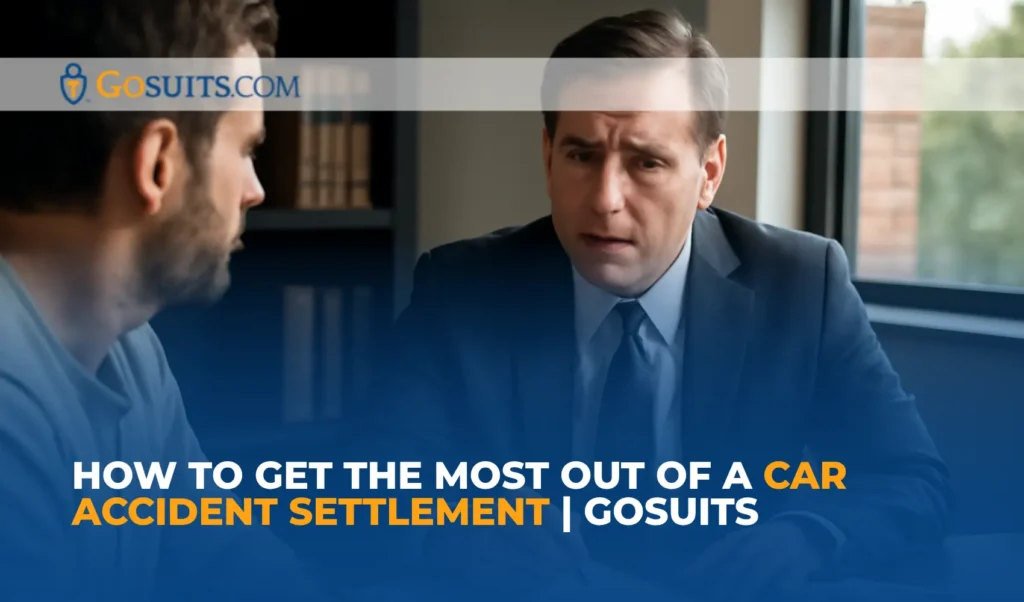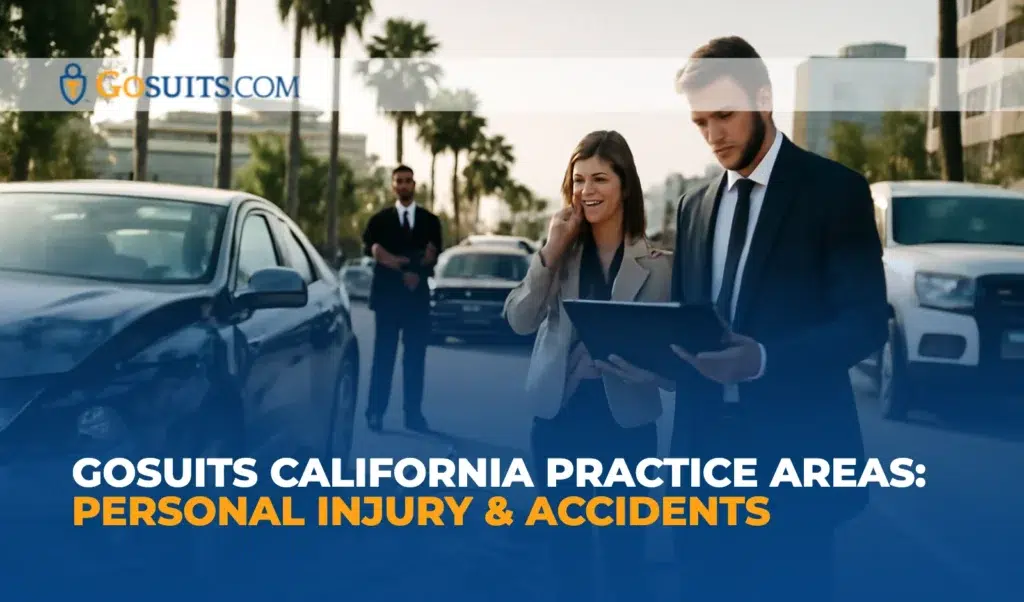- What We Know About the Menifee Motorcycle–Truck Collision
- Location, Time, and Agencies Involved
- Understanding Left-Turn Crashes and Motorcyclist Right-of-Way in California
- Injury Severity and Why Helmets Matter
- What Investigators Typically Look For After a Serious Crash
- How Loved Ones Can Obtain Official Records
- Practical Steps to Preserve Rights After a Severe Injury Collision
- Insurance Considerations After a Motorcycle Crash
- Civil Liability Overview in Two-Vehicle Collisions
- Community Safety Notes for Drivers and Riders at Scott Road and Daily Road
- Key Deadlines Under California Law
- Where to Seek Support and Information in Riverside County
- Why Acting Promptly Matters After a Serious Traffic Crash
- Commentary from Gosuits Menifee, California Personal Injury Attorney
What We Know About the Menifee Motorcycle–Truck Collision
On Monday night in Menifee, a serious traffic collision at the intersection of Scott Road and Daily Road left a 46-year-old motorcyclist in critical condition. According to information released by the Menifee Police Department, the crash occurred around 10:17 p.m. and involved a Toyota truck and a BMW motorcycle, both sustaining major damage. The truck’s driver, a 65-year-old Menifee resident, was not injured and remained at the scene. The rider, who was wearing a helmet, was thrown from the motorcycle and suffered severe injuries before being transported by ambulance to a local hospital, where he remains in critical condition.
Preliminary details indicate the truck was traveling westbound on Scott Road and initiated a left turn onto Daily Road while the motorcycle was traveling eastbound on Scott. Investigators have not yet determined the cause of the crash, and authorities noted that alcohol and drugs do not appear to be contributing factors at this stage. The Menifee Police Department’s Traffic Unit is seeking additional information from witnesses. Individuals with information are encouraged to contact the Traffic Unit at 951-723-1500 or Officer Clay at 951-723-1566.
Our hearts are with the injured rider, as well as his family and friends who are navigating a frightening and uncertain time. The focus now is on recovery, clarity about what happened, and making sure important rights are protected while the investigation proceeds.
Location, Time, and Agencies Involved
The collision occurred at the intersection of Scott Road and Daily Road in Menifee, California. Menifee Police Department personnel responded at approximately 10:17 p.m. Emergency medical services transported the rider to a local hospital. The Menifee Police Department Traffic Unit is leading the investigation.
Because the crash took place at a signalized intersection with mixed residential and commuter traffic patterns, investigators may review intersection timing, sight lines, lighting conditions, and potential video sources from nearby businesses or traffic systems. Witness accounts are especially helpful in this type of opposing-direction left-turn collision.
Understanding Left-Turn Crashes and Motorcyclist Right-of-Way in California
Many serious motorcycle collisions happen during left turns, often because the turning driver fails to accurately gauge the speed or presence of an oncoming rider. California’s rules are clear: a driver turning left must yield the right-of-way to vehicles approaching from the opposite direction that are close enough to pose a hazard. California Vehicle Code section 21801(a) states that drivers intending to turn left must yield to oncoming traffic and may only proceed when reasonably safe to do so. You can read the statute here: Cal. Veh. Code § 21801.
In practice, determining who had the right-of-way depends on timing, speed, signal phasing, roadway markings, and the actions of both parties immediately before the crash. Even when a left-turning driver generally has a duty to yield, fault determinations are fact-specific and may involve shared responsibility under California’s comparative fault system. This is why careful collection of evidence and a full reconstruction can be pivotal.
Safety researchers note that car-versus-motorcycle crashes often involve drivers who did not see the motorcycle in time. National data show that perception and conspicuity challenges contribute to turning conflicts with riders. For broader context on motorcycle crash risks and patterns, the National Highway Traffic Safety Administration offers annual summaries: NHTSA Motorcycles.
Injury Severity and Why Helmets Matter
High-energy impacts at intersections can result in traumatic injuries for riders, including head, spinal, thoracic, and extremity trauma. Being thrown from the bike increases the risk of multiple impact points with the vehicle or roadway.
Helmets are a critical layer of protection. Federal research has consistently shown that helmets reduce the risk of head injury and death in motorcycle crashes. NHTSA reports that helmets are highly effective at preventing fatal head injuries and are estimated to be significantly protective in serious collisions. For more, see NHTSA’s discussion of helmet effectiveness: NHTSA on Helmet Use. The Centers for Disease Control and Prevention similarly outlines the role helmets play in reducing mortality and severe brain injury: CDC Motorcycle Safety.
Even with proper protective gear, a rider can face extensive recovery and long-term rehabilitation after a crash like the one described. Early coordination of medical care, documentation, and follow-up with trauma specialists can make a meaningful difference in outcomes.
What Investigators Typically Look For After a Serious Crash
When a crash results in critical injuries, investigators generally focus on collecting and preserving time-sensitive evidence from the scene and vehicles. This can include:
- Scene evidence such as tire marks, gouge marks, fluid trails, debris fields, and final rest positions.
- Signal timing and phasing data for the intersection, including whether protected left-turn phasing was active, cycle lengths, and offsets.
- Vehicle inspections to examine mechanical condition, damage profiles, lighting, and potential defects.
- Event data from vehicle modules if available, which can sometimes record speed or throttle data in certain vehicles.
- Witness statements and 911 records to establish sequence and timing.
- Environmental conditions like roadway lighting, visibility, weather, and lane delineation.
- Video sources from nearby businesses or traffic infrastructure.
These pieces help reconstruct speed, paths, and right-of-way, and they support determinations about whether the left-turning driver yielded appropriately and whether the oncoming vehicle posed an immediate hazard at the time the turn began.
How Loved Ones Can Obtain Official Records
Obtaining documentation helps families track the investigation and plan for medical and practical needs. Several types of records may be available, each with its own process and timeline under California law.
Police collision report
The investigating law enforcement agency maintains the official collision report. In California, access to collision reports is governed by statute. California Vehicle Code section 20012 addresses confidentiality and who may obtain copies. See the code text here: Cal. Veh. Code § 20012.
Reports are typically released to involved parties, their insurers, and legal representatives. If the California Highway Patrol investigates a crash, requests are commonly made using CHP Form 190; information on CHP collision reports is available at CHP Collision Report Information. For this Menifee incident, the Menifee Police Department is the investigating agency. The Traffic Unit can be reached at 951-723-1500 or Officer Clay at 951-723-1566 for status updates and instructions on obtaining the report when available.
911 audio, CAD logs, and dispatch data
Computer Aided Dispatch summaries, radio traffic, and 911 recordings may be requested under California’s Public Records Act, subject to exemptions for active investigations and privacy. General information about the Public Records Act is provided by the California Attorney General: California Public Records Act overview. These materials can help establish timelines and initial observations by first responders.
Traffic signal timing and roadway data
Signal timing plans, maintenance logs, and phasing diagrams may exist for the Scott Road and Daily Road intersection. Requests can be made to the appropriate public agency under the Public Records Act. Where records exist and are not exempt, they can help clarify whether protective left-turn phases, all-red intervals, or recent timing adjustments might be relevant.
Medical records
Hospitals and treating providers maintain clinical records that document injuries, treatments, and prognoses. Federal and state privacy laws apply. Patients or their authorized representatives can request copies for care coordination and insurance claims. Keeping a complete file of medical records, discharge summaries, imaging reports, and bills is important for any later civil claim.
Autopsy and coroner records
This case was reported as a severe injury, not a fatality. If a collision results in a death, the county coroner is responsible for investigating the cause and manner of death under California Government Code section 27491. The code can be reviewed here: Cal. Gov. Code § 27491. Next of kin may request certain coroner records; release timelines and available documents vary by county and case status.

Practical Steps to Preserve Rights After a Severe Injury Collision
In the immediate aftermath, it can be difficult to know what to do first. The following practical steps are general guidance to help keep options open while the investigation proceeds. These are not case-specific recommendations and are offered for general information only.
- Collect and secure evidence. Preserve photos and videos of the scene, vehicles, road conditions, and injuries. Save dashcam files. Identify potential witnesses and save their contact information. If vehicles are towed, note the storage location.
- Maintain a medical journal. Track symptoms, appointments, medications, and work impacts. Save all discharge paperwork and imaging reports. This record supports continuity of care and documents the trajectory of recovery.
- Request official documents as they become available. Follow up with the investigating agency for the collision report and, where appropriate, consider Public Records Act requests for dispatch logs or signal timing records.
- Be cautious with insurance communications. Before making recorded statements to any insurer, consider consulting an attorney. Statements can be used later to challenge or limit claims. More on this below.
- Do not repair or dispose of involved vehicles without documenting them. Vehicle damage is often a key part of crash reconstruction. High-resolution imagery and, when feasible, an inspection by a qualified professional can be critical.
- Track out-of-pocket costs. Keep receipts for medical co-pays, prescriptions, adaptive equipment, transportation to medical appointments, and other related expenses.
Insurance Considerations After a Motorcycle Crash
Insurance issues after a severe injury collision can be complicated. Policies that may be involved include the at-fault driver’s liability coverage, the rider’s own motorcycle policy, medical payments coverage, and possibly uninsured or underinsured motorist coverage if liability or limits become disputed.
- Liability coverage. The turning driver’s insurer and the rider’s insurer may both become involved. Fault determinations are typically contested in left-turn crashes, and adjusters will examine every detail to apportion liability.
- Medical payments (MedPay). Some motorcycle policies offer MedPay that can help with immediate medical bills regardless of fault, subject to limits and exclusions.
- Uninsured/underinsured motorist (UM/UIM). If the at-fault party is uninsured or lacks sufficient limits to cover serious injuries, UM/UIM provisions on the rider’s policy may provide additional protection.
- Property damage and gear. Claims may include the motorcycle, helmet, riding gear, and mounted equipment such as phones and cameras.
Insurance companies often seek recorded statements and medical authorizations early. It is generally prudent to consult with an attorney before speaking with any insurance company. Individuals should know that what they say to an insurer can be used against them later to reduce or deny claims. A free consultation helps people understand their rights and obligations before making statements or signing releases.
Civil Liability Overview in Two-Vehicle Collisions
California law allows injured people to pursue civil claims for harms caused by another’s negligence. In two-vehicle intersection crashes, potential liability considerations include:
- Right-of-way and yielding. Whether the left-turning driver yielded as required by Cal. Veh. Code § 21801.
- Speed and distance. Whether the oncoming rider was so close as to constitute an immediate hazard when the turn began, and whether speed estimates are supported by physical evidence.
- Signal compliance. Whether turn movements and through movements were made on a green, protected arrow, flashing yellow, or red phase.
- Visibility and environment. Lighting conditions, obstructions, lane markings, and roadway design can influence perception and decision-making.
- Comparative fault. California’s comparative negligence system apportions responsibility when more than one party’s actions contributed to the crash. Compensation can be adjusted according to percentages of fault assigned by a jury or through settlement.
These determinations rely on evidence and analysis rather than assumptions. Careful documentation helps clarify how and why the collision occurred.
Community Safety Notes for Drivers and Riders at Scott Road and Daily Road
Opposing-direction left turns at night require heightened attention from everyone on the road. Drivers turning left should pause to assess oncoming vehicles and avoid committing to a turn unless there is a clear, safe gap. Riders approaching intersections should anticipate potential turning movements and position themselves for visibility while maintaining a speed appropriate to conditions.
Statewide safety programs emphasize slowing at intersections and scanning for vulnerable road users. For general motorcycle safety information and strategies to reduce intersection conflicts, see the California Office of Traffic Safety resources: OTS Motorcycle Safety.
Key Deadlines Under California Law
Timing matters in civil claims. California sets deadlines that, if missed, can prevent recovery. The following are general references:
- Personal injury statute of limitations. In most cases, a person has two years from the date of injury to file a civil lawsuit for personal injury in California. See Code of Civil Procedure section 335.1: Cal. Code Civ. Proc. § 335.1.
- Claims against public entities. If a public entity may be involved, a government claim usually must be presented within six months of the incident under Government Code section 911.2. See the statute here: Cal. Gov. Code § 911.2.
These timelines are subject to exceptions and nuances, and additional notice requirements may apply in particular circumstances. Early consultation can help clarify which deadlines apply.
Where to Seek Support and Information in Riverside County
Several organizations and offices can offer information or services after a serious crash:
- Menifee Police Department Traffic Unit. Primary investigating agency for this crash. For witness tips, report status, and process questions: 951-723-1500 or Officer Clay at 951-723-1566.
- California Highway Patrol. For general information on collision reports and traffic safety statewide, see CHP Collision Report Information.
- California Office of Traffic Safety. Safety programs and data related to motorcycle crashes: OTS.
- California Courts. General civil case information and resources: California Courts Self-Help.
- Riverside County Coroner. If a crash results in a fatality, the county coroner handles cause and manner of death investigations under Cal. Gov. Code § 27491. Next of kin can request information and, when available, certain records. Contact details vary by county; families can call the county sheriff-coroner’s office directly for procedure and hours.
Support groups and hospital social work teams can also help with care coordination, transportation logistics, and connecting with community resources.
Why Acting Promptly Matters After a Serious Traffic Crash
What to do
- Secure the collision report and related public records once available from the investigating agency, and consider requesting dispatch logs or traffic-signal timing records where relevant.
- Compile medical documentation from all facilities and providers, including imaging, operative reports, and therapy notes.
- Preserve physical and digital evidence such as vehicle damage, helmet and gear, photos, and any dashcam footage.
- Track financial impacts including medical expenses, mileage to care, time off work, and caregiver needs.
- Consult an attorney before speaking to insurance companies about the crash or injuries. Initial statements can shape the entire claim.
Why acting now matters
- Evidence is perishable. Skid marks fade, vehicles get repaired, and video systems overwrite footage. Early action preserves objective proof of what happened.
- Deadlines run quickly. California law imposes strict timelines, including a two-year personal injury statute of limitations and a six-month claim window for certain public-entity matters. Missing a deadline can eliminate legal options.
- Medical continuity supports recovery. Prompt follow-up care and documentation strengthen treatment outcomes and provide a clear record of injuries and needs.
- Insurance positioning starts early. Adjusters begin shaping claim narratives immediately. Without informed guidance, important rights can be compromised.

Context and urgency
Intersection crashes with severe injuries often require extensive reconstruction and medical assessment. The sooner records are requested, evidence is preserved, and care plans are coordinated, the better the opportunity to understand the event and to support a path forward. Waiting can result in missing video, incomplete documentation, or miscommunications that are difficult to correct later. A no-cost legal consultation is a prudent first step to understand rights and obligations before interacting with insurers.
Commentary from Gosuits Menifee, California Personal Injury Attorney
Our thoughts are with the injured rider and everyone who cares about him. A sudden, life-altering crash is overwhelming, and it is understandable to feel uncertain about what comes next. This overview is intended for educational purposes and general information only, to help the community understand how these cases are typically evaluated and what information may matter most.
Opposing-direction, left-turn collisions are especially dangerous for motorcyclists. California law requires left-turning drivers to yield to oncoming traffic that constitutes an immediate hazard, but every case turns on specific facts like speed, signal timing, sight lines, and the precise moment the turn began. Until investigators complete their work and the physical and documentary evidence is fully reviewed, it is premature to draw conclusions. Careful attention to preserving scene evidence, identifying witnesses, and obtaining signal and dispatch data often proves crucial in determining how and why such a crash occurred.
Insurance companies and large corporate actors move quickly after serious events. They gather statements, request broad medical authorizations, and sometimes steer conversations in ways that minimize responsibility or shift blame. Many people do not realize that seemingly simple statements about speed, distance, or pain levels can later be used to limit or dispute claims. Early, informed guidance helps level the playing field and prevents avoidable mistakes.
A free consultation provides a chance to understand rights, timelines, and options before talking to insurers or signing documents. It is an opportunity to ask questions, get oriented, and decide on next steps with clarity. In a case involving critical injuries, that early clarity can make a meaningful difference in preserving evidence, coordinating care, and protecting the interests of the person who is hurt.
References
- California Vehicle Code § 21801 (Left turns)
- California Vehicle Code § 20012 (Collision report confidentiality and access)
- California Public Records Act overview, California Attorney General
- NHTSA Motorcycle Safety
- NHTSA on Motorcycle Helmets
- CDC Motorcycle Safety
- California Office of Traffic Safety Motorcycle Safety
- California Highway Patrol Collision Report Information
- California Code of Civil Procedure § 335.1 (Personal injury statute of limitations)
- California Government Code § 911.2 (Government claims deadline)
- California Government Code § 27491 (Coroner duties)






